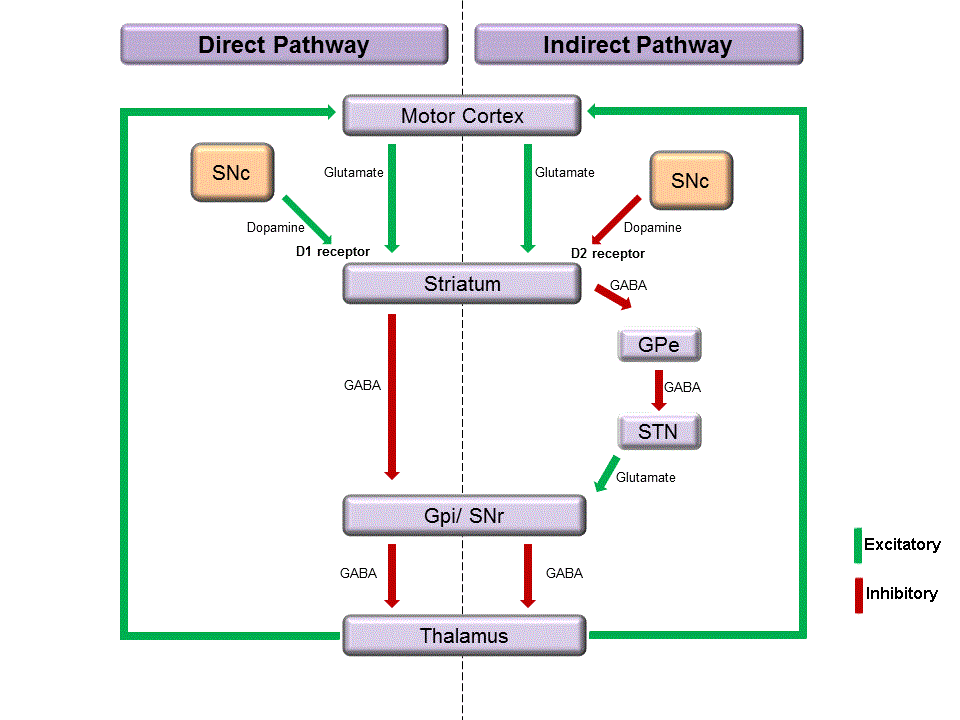WBR0611
| Author | [[PageAuthor::Rim Halaby, M.D. [1] (Reviewed by Yazan Daaboul, M.D.)]] |
|---|---|
| Exam Type | ExamType::USMLE Step 1 |
| Main Category | MainCategory::Pathophysiology |
| Sub Category | SubCategory::Neurology |
| Prompt | [[Prompt::A 62-year-old man presents with complaints of a tremor in both hands. The tremor initially started in his right hand and has recently progressed over the past 4 weeks to involve his lips and his left hand. The patient also reports the tremor intensity decreases when he intentionally moves his hands, and it disappears when he sleeps. Physical examination is remarkable for a resting tremor, bradykinesia, rigidity, and shuffling gait. Which of the following is the most likely pathological mechanism responsible for this patient’s condition?]] |
| Answer A | AnswerA::Reduced stimulation of the direct pathway via D1 receptors |
| Answer A Explanation | [[AnswerAExp::Dopamine is released from the substantia nigra compacta and binds to D1 receptors of the striatum to stimulate the direct pathway of the basal ganglia. In Parkinson's disease, dopamine depletion results in a reduced stimulation of the direct pathway via D1 receptors.]] |
| Answer B | AnswerB::Reduced stimulation of the indirect pathway via D1 receptors |
| Answer B Explanation | [[AnswerBExp::Dopamine is released from the substantia nigra compacta and binds to D2 receptors of the striatum to inhibit the indirect pathway of the basal ganglia. In Parkinson's disease, dopamine depletion results in a reduced inhibition of the indirect pathway via D2 receptors.]] |
| Answer C | AnswerC::Reduced stimulation of the direct pathway via D2 receptors |
| Answer C Explanation | AnswerCExp::The activity of the direct pathway is reduced due to a reduced release of D1, which normally bind to D1 receptors of the striatum. |
| Answer D | AnswerD::Reduced inhibition of the direct pathway via D1 receptors |
| Answer D Explanation | AnswerDExp::Depletion of dopamine results in reduced inhibition of the indirect pathway via D2 receptors. |
| Answer E | AnswerE::Greater inhibition of the indirect pathway via D2 receptors |
| Answer E Explanation | AnswerEExp::In Parkinson's disease, depletion of dopamine results in a reduced inhibition of the indirect pathway via D2 receptors. |
| Right Answer | RightAnswer::A |
| Explanation | [[Explanation::The patient in this vignette is most likely diagnosed with Parkinson's disease, a neurodegenerative disease characterized by depletion of dopamine-producing cells in the substantia nigra compacta (SNc). The patient's age, progressive tremor that involves both extremities and his lips and improves with intentional movement and sleep, and the signs on physical examination (resting pill-rolling tremor, bradykinesia, rigidity, and shuffling gait) are all features of Parkinson's disease.
There are two pathways in the basal ganglia that control the fine tuning of voluntary motor activities: the direct excitatory pathway and the indirect inhibitory pathway. These pathways have antagonistic net effects. Stimulation of the direct pathway results in activation of the motor cortex, whereas stimulation of the indirect pathway results in the inhibition of the motor cortex. Dopamine is released from the substantia nigra compacta (SNc), binds to D1 receptors of the striatum, and stimulates the direct pathway. At the same time, D2 is released from the SNc and binds to D2 receptors of the striatum to inhibit the indirect pathway. The activity from both pathways aims to stimulate the motor cortex.
In patients with Parkinson's disease, the reduction in dopamine results in a reduced activation of the direct pathway through D1 receptors and reduced inhibition of the indirect pathway through D2 receptors. Accordingly, the activity of the motor cortex is reduced, resulting in the characteristic rigidity.
|
| Approved | Approved::Yes |
| Keyword | WBRKeyword::Resting tremor, WBRKeyword::Parkinson's disease, WBRKeyword::Basal ganglia, WBRKeyword::Dopamine, WBRKeyword::Rigidity, WBRKeyword::Direct pathway, WBRKeyword::Indirect pathway, WBRKeyword::Bradykinesia, WBRKeyword::Shuffling gait, WBRKeyword::Tremor |
| Linked Question | Linked:: |
| Order in Linked Questions | LinkedOrder:: |
